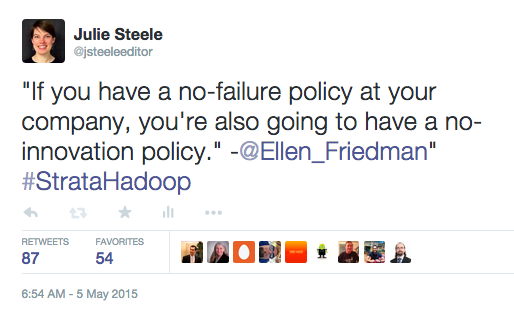
5 Ways to Facilitate Failure
May 19th, 2015
At the Strata + Hadoop World conference in London a couple weeks ago, Ellen Friedman gave a wonderful talk called, “Big Data Stories: Decisions that drive successful projects.” One of her points, about the need for room to fail in order to innovate, got us thinking—again—about the critical role of failure and experimentation when it comes to innovation.
The idea of “freedom to fail” as a condition necessary for achieving transformative change is now widely accepted in our industry. Indeed, many smart people have been beating this drum for years now. But not many companies have yet found a way to create this freedom while simultaneously maintaining smooth enterprise-scale operations. Failure is appealing as a stepping stone along the path to innovation, but it’s very scary in practice—especially when you can’t yet see where the path is leading.
We’d like to suggest the following five guidelines as a place to start when you design for investigation and innovation—and the inevitable failures you’ll have along the way. We call this the Experimental Enterprise.
1. Build a Bridge to the Business
Innovation must not interfere with the important production processes of a business, but it can’t be too far removed from it, either. It’s not enough to create segregated areas for each: there needs to be a tie, otherwise you’ll never get innovation that’s relevant to the business, or you’ll never be able to actually turn it into product. Design a sandbox in which innovation can play alongside production.
2. Make Failure Affordable
Some industries are more risk-averse than others because of the amount of overhead involved. If you’ve ever complained about the slew of crappy movie sequels and comic remakes, then you’ve noticed Hollywood’s increasing reticence to make anything that doesn’t yet have a proven audience. The toy industry is similar: endless Elmos and Doras crowd the shelves because toymakers are unwilling to take a risk on anything that might not sell enough units to cover their overhead costs. Shrink overhead where you can to make failure affordable.
Remember: failure needs to be cheap both economically and politically. It’s dangerous to pin reputations and kudos to pilot projects. Every organization has the two-year-old pilot project that refuses to die, because those involved have too much at stake. The worst fate for a pilot is to neither succeed nor fail, but instead to wander on, zombie-like, in limbo.
3. Crunch the Numbers
“Freedom to Fail” doesn’t exempt you from projecting an ROI. If a project is untested or truly innovative, it becomes even more imperative to get a good grasp of what you stand to gain, and what you’ve laid on the table. Understanding the stakes will allow you to gauge the trade-offs and make others in your organization more comfortable with the possibility of failure.
4. Invest in Learning
Playing the lottery is a stupid get-rich-quick scheme, but it’s affordable entertainment: what you’re really buying when you buy a mega-millions ticket is not any real possibility of becoming wealthy, but the license to dream for a few days about what would happen if you did. Viewed in that light, it’s cheaper (by the hour) than many other forms of entertainment.
If you can similarly measure your corporate experiments by what you stand to gain when you lose, then the value proposition shifts. Structure your projects so that even if you fail, you fail in a way that allows you to learn something valuable. If the experiment doesn’t succeed, you’ve still gotten something back on your investment; and if the experiment does succeed: jackpot!
5. Be a Chicago Voter
The best way to learn, of course, is to fail like they vote in Chicago: early and often. Failing quickly and repeatedly is a discovery mechanism for the contours of the problem space—it gives you a “fingertip feel” for the area. The faster you fail, the tighter your feedback loop will be, allowing a more effective response to changing market conditions and political whims.
It’s probably apparent that an organization designed for scale and efficiency is completely at odds with the organizational design required for experimentation. Your company needs to recognize this at the highest levels and make room. The young rockstars will say your organization is failing because it can’t innovate, and the old guard will say the new kids don’t know how to run anything in production. Both are right, and both are wrong.
It’s the organizational know-how to run and to innovate in parallel—and to bridge the two—that’s the secret sauce. At a technical level, this is where platforms and APIs count for a lot. But there’s an organizational analog, too: certain roles allow for people to act as political bridges. You want to have both in place.
For more on how to build an adaptive environment, check out our free whitepaper on Building the Experimental Enterprise. For further reading, we recommend Dealers of Lightning: Xerox PARC and the Dawn of the Computer Age (HarperBusiness) by Michael A. Hiltzik and The Connected Company (O’Reilly Media) by Dave Gray with Thomas Vander Wal.






